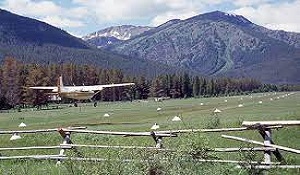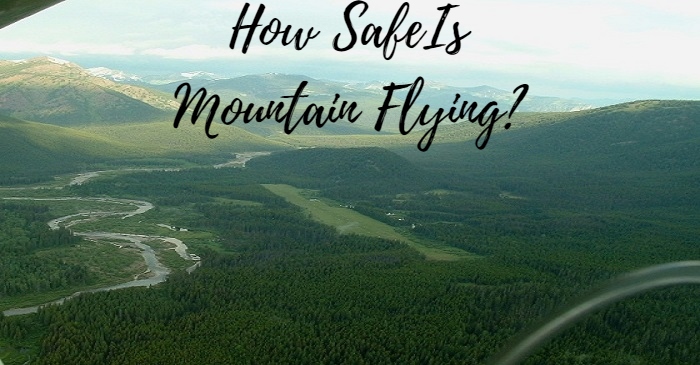
I am sure many pilots wonder How Safe Is Mountain Flying? I grew up in the Rocky Mountains so naturally, I learned to fly there. My training from student pilot to (ATP) was flying in the mountains so I love it. However, it must be done safely.
How Safe Is Mountain Flying?
Mountain flying can be hazardous in bad weather conditions and without training. Extreme wind can create downdrafts and updrafts and severe turbulence so caution is necessary. Properly trained pilots can experience a very fun and rewarding time with their new skills.
1. What Is Mountain Flying?
There really isn’t a true definition of mountain flying other than flying in mountainous terrain. You can find mountain waves, turbulence, and high-density altitudes far out into the plains. Especially in the high plains of Colorado, Wyoming, Montana, and British Columbia.
I flew a U.S. Mail run across the Rocky Mountain Front in Montana for many years six times per week from Glacier Park International Airport to Billings Logan International at night. There was a point 50 miles west of Great Falls, MT, and about 35 miles west of the mountains that I called the chuckhole.
This was an area of turbulence that was always present no matter the winds aloft. And of course, it was much worse in high wind.
It was a good idea to slow the aircraft to design maneuvering speed when the weather and winds were bad.
2. Experience. For Safe Mountain Flying.
Flying in the mountains is a beautiful ride, especially seeing the mountain tops, valleys, lakes, and unspoiled wilderness. It can be mesmerizing and can lead a pilot into a place of no return.
It is a good idea to take a mountain flying course to learn about the intricacies of mountain flight. The class will give you knowledge about mountain flight but it would be well advised to do at least 15 hours with an instructor or a pilot that has experience after ground school.
My job as the training Captain and Check Airmen for a FAR Part 135 operator entailed training pilots in ground and flight instruction. We operated throughout Colorado, Utah, Montana, and Wyoming so it was essential to cover mountain flying well.
I had the experience. I flew runs from Denver to Aspen, Rifle, Grand Junction Steamboat Springs CO, plus Rock Springs, and Casper WY. Our operations based in Billings MT serviced all the major areas of Montana including Butte MT., which is considered to be #3 on the list of airports pilots don’t like to fly into, while Aspen is #1.
Have a look at a takeoff and landing at Schafer Meadows USFS Airfield in the Great Brear Wilderness south of Glacier National Park, Montana.
3. Windward and Leeward.
Safe mountain flying is possible if a pilot is aware of the places not to go. Like flying up a box canyon without considering an exit strategy.
Remember to be prepared for anything so always look for places where you could land if necessary.
Windward-facing mountains will provide lift because the air is moving up the slope so an updraft is created. In contrast, leeward-facing mountains will contain downdrafts which when given little or no thought could create a downward force on the airplane that could exceed the aircraft’s ability to climb and an accident may become a reality.
There can be some fairly turbulent air on both sides of a mountain but the leeward side poses the greatest threat.
Downdrafts and turbulence can extend long distances from the mountain ranges so keep that in mind when flying near mountain ranges.
4. Density Altitude. Safe Mountain Flying.
High-altitude airports and high temperatures just don’t mix well. Private Pilot training covers density altitude and it is a subject that can never be taken lightly.
It is pressure altitude corrected for temperature.
Being a very dangerous problem, it needs to be a very important aspect of any flight when temperature and altitude are mixed.
For example, a backcountry trip to a remote wilderness airstrip with a short grass field and an airplane full of people and gear might make me want to check my takeoff data to be assured I have an adequate runway plus a margin of error for a successful takeoff roll. My takeoff may have to be early in the morning when temperatures are cooler to fly out.
Flying in the mountains is as safe as a pilot wants it to be. Be situational aware all the time.
There is a great deal of information on the FAA website that I recommend taking time to read. This article, “Tips on Mountain Flying” that you can read here has some great information.
5. Practice, Practice, Practice.
Shortly after I bought a 1974 Cessna 172 to finish my Private Pilot Certificate an instructor who was a WWII Pilot took the time to teach me a few things that were not in the syllabus. He knew I would be flying into short and soft fields so he took the time to teach me the safe ways to do just that.
This is training that is taught for the Private Certificate so it is something a pilot should master. It is quite fun to challenge yourself to make great landings and learn short and soft field landings.
These can be practiced on hard surfaces before trying the real thing. Once you have your solo behind you practicing mastery is what you do.
Become one with the airplane. It lives for your command.
6. Assess The Risk.
Before any flight in any weather, VFR, or IFR, the risk must be assessed to assure the safety of the flight.
Mountain flying imposes a bit more risk than flying over the Great Plains but do not misunderstand this. I have had some flights over the Plains that have tested my abilities to the maximum. One nearly cost my life.
Conclusion:
I personally love mountain flying because I know my limitations and I better know the limits of the airplane I am flying.
There are far more factors involved in mountain flying than the discussion here but serious aviators will take the responsibility for human life and property seriously and fly safely.
Mastery of flying an airplane and take-offs and landings is essential in all aspects of aviation. Mountain flying poses greater risks but manageable risks are acceptable.
The freedom that backcountry flying avails is worth every minute of training and seeing a country that possibly no human has ever set foot in is awe-inspiring to me.
The fact is that mountain flying is very safe if you fly the airplane first. Learn the rules before you lose your life being heroic. A lot of us have come before and lived to fly another day.
Related: Is Instrument Flying Safe? (5 Whats? About Instrument Pilots)
Please leave a comment or tell a story about your experience.
